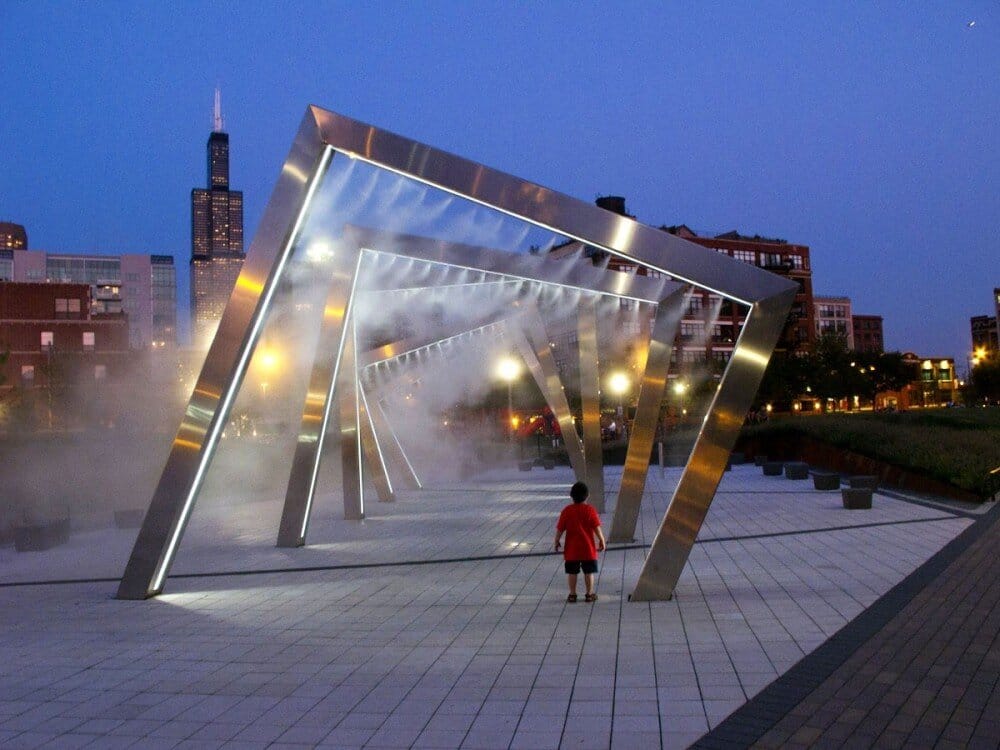
5 interesting facts about West Loop
Originally home to industrial spaces and wholesale food markets, West Loop is exploding with modern high-rises, top-tier restaurants and new residential and office buildings, many adaptively reused.
Originally home to industrial spaces and wholesale food markets, West Loop is exploding with modern high-rises, top-tier restaurants and new residential and office buildings, many adaptively reused.
by Ellen Shubart, CAC docent
Here are five interesting facts about this quickly evolving neighborhood:
1. ONE OF ITS MAIN DRAWS IS GREEKTOWN, IN THE NEIGHBORHOOD’S SOUTHEAST CORNER.
Greeks began arriving in Chicago in the 1840s and settled in the area near Halsted and Harrison streets. Many worked as food peddlers and later became restaurant owners. The small collection of Greek restaurants that still exist in the neighborhood today opened mostly between the 1970s and 1990s. Each summer, Greek food also draws thousands of people to the Taste of Greece festival on Halsted Street.
Several monuments built in the traditional Greek style—including a colosseum and a statue of the Greek goddess Artemis—reflect the neighborhood’s Greek heritage, along with the National Hellenic Museum on Halsted Street. More recent additions to the neighborhood, like Arkadia Tower, have design features that give a nod to Greece. The 33-story tower, designed by Fitzgerald Associates, features highly visible, perforated garage screens that depict marathon runners and the Parthenon.
2. IT IS HOME TO SOME OF THE TOP RESTAURANTS IN THE CITY, AND THE NATION.
Randolph Street is the city’s longest Restaurant Row, with more Michelin award-winners than any other city area. Restaurants like Smyth, Au Cheval, Elske and The Aviary rank among the most acclaimed eateries in Chicago. Long before these places were even imagined, Randolph Street was a food hub, in the form of a large wholesale produce market. Just two blocks north, on Fulton Market Street, stood much of the city’s meatpacking industry. Other food-oriented businesses, like bakeries and barrel makers, moved in, followed by other manufactured goods. Over time, these shops morphed into open-air restaurants and patios, with decorative terra cotta floral facades and large doorway openings that previously welcomed delivery.
3. IT WAS THE SITE OF A SIGNIFICANT RIOT BY LABOR ACTIVISTS FIGHTING FOR AN 8-HOUR WORKDAY.
On May 4, 1886, labor activists and anarchists called for a mass meeting in Haymarket Square, located on Randolph Street between Desplaines and Halsted streets. They gathered to protest police brutality toward McCormick Harvesting Machine Company plant workers who were on strike. The day before, police killed two of the workers who had been striking in an effort to get their employer to agree to an 8-hour workday. Activists came out in droves the following day to speak out against their deaths. During the rally, an unidentified person detonated a bomb, killing police officers and protestors. Afterward, eight of the radical labor activists were convicted of murder for conspiring with the bomber, despite lack of evidence. The Haymarket Riot had a lasting effect on the labor movement in the U.S. and has been commemorated in monuments around the world, including a bronze sculpture erected in 2004 on Desplaines Street designed by sculptor Mary Brogger.
4. ONE OF ITS PARKS IS NAMED AFTER ILLINOIS’ FIRST FEMALE JUDGE.
Designed by Chicago landscape architect Ernest Wong, Mary Bartelme Park is a 1.4-acre recreation ground that provides a much-desired park and playground for younger families flocking to the neighborhood. Mary was the state’s first woman judge. In the late 1890s, she helped establish America’s first juvenile court. Nicknamed “Suitcase Mary,” she provided suitcases filled with clothing and toiletries to women leaving the jail system, and donated her home to establish Mary’s Club, a group home for girls. Her namesake park features three diagonal paths that intersect to create several zones: a children’s play area, a sunken dog park and an open lawn. The often-photographed “fountain plaza” features five stainless steel askew arches, which emit a water mist on Chicago’s hottest days. Salvaged terracotta from a historic infirmary—the site’s original occupant—creates seating around the park’s native landscaping.
5. OPRAH WINFREY AND MCDONALD’S ARE A FEW OF THE BIG NAMES ASSOCIATED WITH WEST LOOP.
For 25 years, Oprah Winfrey filmed her show in Harpo Studios, located within a massive, century-old building at Washington Boulevard and Carpenter Street. The building previously had many other uses, such as being a staging area for police in the Haymarket Riot, and as a temporary morgue after the Eastland Disaster in 1915. In 2016, the building was demolished to make room for the new McDonald’s corporate headquarters. McDonald’s is one of more than 50 companies that have moved from the suburbs to Chicago and many of them are selecting West Loop as their new home. Other big names with West Loop offices include Google, Sara Lee and Uber.
